初中英语易混知识点辨析
初中英语易混词、短语辨析
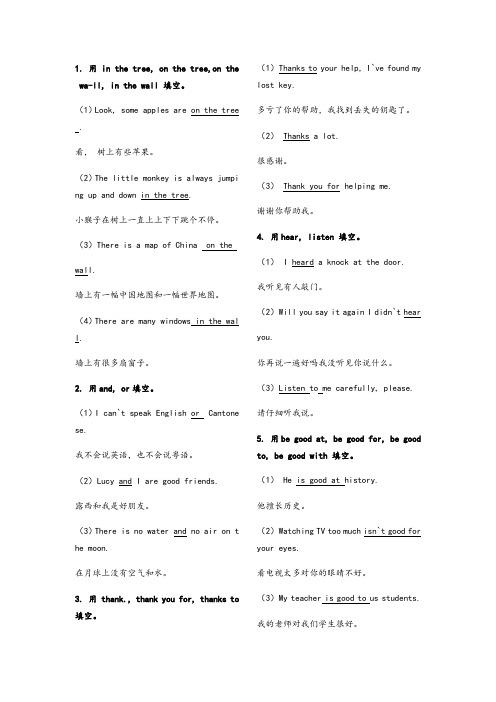
1. 用 in the tree, on the tree,on the wa-ll, in the wall 填空。
(1)Look, some apples are on the tree .看,树上有些苹果。
(2)The little monkey is always jumpi ng up and down in the tree.小猴子在树上一直上上下下跳个不停。
(3)There is a map of China on thewall.墙上有一幅中国地图和一幅世界地图。
(4)There are many windows in the wal l.墙上有很多扇窗子。
2. 用and, or填空。
(1)I can`t speak English or Cantone se.我不会说英语,也不会说粤语。
(2)Lucy and I are good friends.露西和我是好朋友。
(3)There is no water and no air on t he moon.在月球上没有空气和水。
3. 用 thank., thank you for, thanks to 填空。
(1)Thanks to your help, I`ve found my lost key.多亏了你的帮助,我找到丢失的钥匙了。
(2) Thanks a lot.很感谢。
(3) Thank you for helping me.谢谢你帮助我。
4. 用hear, listen 填空。
(1) I heard a knock at the door.我听见有人敲门。
(2)Will you say it again I didn`t hearyou.你再说一遍好吗我没听见你说什么。
(3)Listen to me carefully, please.请仔细听我说。
5. 用be good at, be good for, be good to, be good with 填空。
九年级英语易错题归纳

九年级英语易错题归纳对于九年级的学生来说,英语学科的难点和易错点主要集中在语法、词汇和阅读理解等方面。
以下是一些常见的易错题及其原因分析,希望能帮助同学们更好地掌握英语学习的方法和技巧。
一、语法易错题1. 时态和语态:在描述过去、现在或未来的事件时,容易混淆时态,如“Yesterday, I have finished my homework.”(正确的时态应该是“Yesterday, I finished my homework.”)。
同时,对于一般现在时、现在进行时、现在完成时等不同时态的区别和用法也容易混淆。
2. 名词和冠词:名词的单复数形式、可数与不可数名词的区分,以及冠词的用法(如“a/an”与“the”的区别)是常见易错点。
例如,“There is a apple on the table.”(正确的说法应该是“There is an apple on the table.”)。
3. 动词和介词:动词的过去式、过去分词以及动词不定式等形式的用法,以及介词后面接名词、代词或动名词的形式,容易出错。
例如,“He is come here.”(正确的说法应该是“He has come here.”)。
二、词汇易错题1. 同义词和反义词:对于一些意思相近或相反的词汇,容易混淆。
例如,“buy”和“purchase”,“increase”和“decrease”等。
2. 一词多义:某些单词在不同语境下有不同的意思,容易造成误解。
例如,“bank”既可以表示“银行”,也可以表示“河岸”。
三、阅读理解易错题1. 细节理解题:对于文章中的某个具体细节或事实,容易理解错误或忽略。
2. 推理判断题:对于作者的观点、态度或意图进行推断时,容易过度解读或误解。
初中英语易混淆单词及短语简析

p se g r・ a sn es
A. o wih g t C.p a t ly wih
B.h l t ep wih D. a t de lwi h
A.p c p ik u
B.ma e u k p
C. e p g tu
D.s n p edu
“ 助某 人 ” 帮 之义 ;el i d a wt h是 “ 处理 , 付 , 对
涉及 ” 的含义 。
3 一 Mo . m,c n I a
— —
ቤተ መጻሕፍቲ ባይዱ
射, 使上 升 ” 的含义 。
t he TV?1wa tt n o
7 一 W h r r c o l lt e . o y u . e e a e my s h o oh s d o c
思。
6 .~ W h tr l o we h v n te hih y a u e d a e o h g wa ?
一
Bu o tt n h y tId n’ hi k te
c a! ot
h s n w i e
Bu e o c r a e s s r a s r no al we o t l o d t
【 解析 】 正确 的选择应 该是 A。owt g i h在这
儿是 “ … …相 配 , 跟 与… …相 伴” 的意思 ;l pa y wt i h的 意思 是 “ 玩弄 ,戏 耍 ”h l i :epwt h是
【 析 】A 为正 确 答 案 ,有 “ 车 接 载 解 用
( )拿 起 , 起 , 加 ( 人 , 捡 增 速度 ) 的 意思 ; a e ” m k u p有 “ 造 , 成 , 构 , 妆 ” 含 义 ;e 编 组 虚 化 的 gt u p有 “ 床 . 来 ” 意 思 : n p有 “ 起 起 的 s du e 发
2024中考备考英语重难点01 易混名词辨析(解析版)
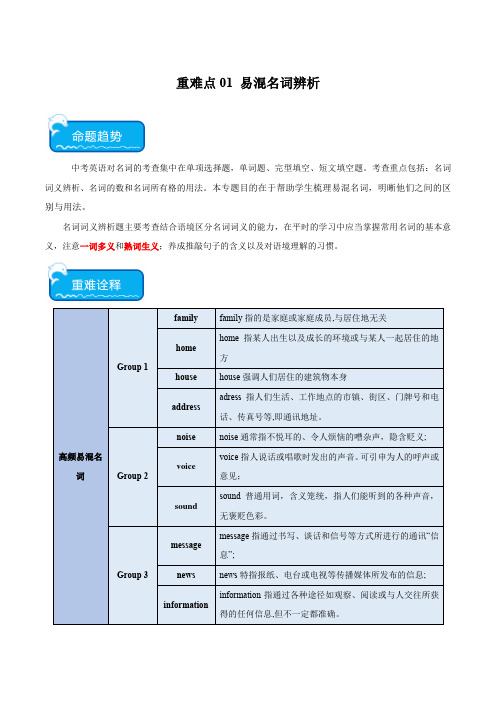
重难点01 易混名词辨析中考英语对名词的考查集中在单项选择题,单词题、完型填空、短文填空题。
考查重点包括:名词词义辨析、名词的数和名词所有格的用法。
本专题目的在于帮助学生梳理易混名词,明晰他们之间的区别与用法。
名词词义辨析题主要考查结合语境区分名词词义的能力,在平时的学习中应当掌握常用名词的基本意义,注意一词多义和熟词生义;养成推敲句子的含义以及对语境理解的习惯。
(2023中考真题建议用时:15分钟)1.(2023·辽宁鞍山·中考真题)—Why does Mary get good grades each time?—I think that’s because she puts most of her ________ into her schoolwork.A.energy B.practice C.exercise D.process2.(2023·内蒙古·中考真题)—The model plane is wonderful! How did you make it?—It’s easy. Follow the ________ and you can do it, too.A.discussion B.education C.conditions D.instructions3.(2023·江苏淮安·中考真题)As a student, you should keep a ________ between your schoolwork and yourhobbies.A.diary B.record C.secret D.balance4.(2023·湖北襄阳·中考真题)—Mr. Fan runs at least half an hour every day.—What a good ________! No wonder he looks healthy.A.habit B.question C.article D.prediction5.(2023·湖北黄石·中考真题)—Could you tell me the ________ of making such tasty dumplings?—Well, I just follow the steps on Tiktok.A.cost B.method C.time D.menu6.(2023·内蒙古呼和浩特·中考真题)High-speed trains are seen as one of the new Four Great ________ of China.A.Inventions B.Advantages C.Environments D.Technologies7.(2023·江苏常州·中考真题)After she was brought back to China, the sick giant panda Ya Ya received good ________ in her new home and got better.A.education B.communication C.entertainment D.treatment8.(2023·江苏南通·中考真题)—________ are easily made, but not easily kept.—That’s true. Once you make one, be sure to keep it.A.Speeches B.Decisions C.Promises D.Suggestions9.(2023·江苏镇江·中考真题)The main ________ of the cities along the Grand Canal (大运河) is history and culture.A.attraction B.pollution C.invention D.situation10.(2023·青海·中考真题)A taxi driver prevented (阻止) an _________ when he saw a car with serious problems travelling across Huangnan.A.accident B.interview C.advertisement11.(2023·山东青岛·中考真题)Before flying a plane, a ________ must take a lot of training.A.policeman B.musician C.nurse D.pilot12.(2023·湖北十堰·中考真题)—How did you fix up the machine, dad?—It’s easy. I just followed the ________.A.instructions B.inventions C.interviews D.influences13.(2023·江苏徐州·中考真题)Of all the ________, I love summer best.A.seasons B.subjects C.colours D.hobbies14.(2023·辽宁丹东·中考真题)Mary’s parents are interested in ________, so they often take her to concerts.A.sports B.music C.science D.movies15.(2023·江苏宿迁·中考真题)—The girl’s beautiful pronunciation caught our ________ in yesterday’s English speech competition.—Yes, many students couldn’t help cheering for her.A.condition B.attention C.invention D.position16.(2023·江苏泰州·中考真题)—Good news! The Chinese women table tennis team won a gold and a silver again.—Great! No matter who wins the medals, it is the ________ of our country.A.price B.pioneer C.pride D.pain17.(2023·黑龙江牡丹江·中考真题)Although our school life is a little busy, it is full of ________.A.pain B.sadness C.laughter18.(2023·四川遂宁·中考真题)—Which movie would you like to watch, Tracy?— Um…it’s hard to make a ________.A.survey B.choice C.call D.wish19.(2023·辽宁·中考真题)Thanks to the teacher’s help, I solved all the ________ easily.A.chances B.problems C.habits D.grades20.(2023·辽宁营口·中考真题)Scientists who are full of ________ always come up with new ideas and bring great changes to our life.A.instruction B.instrument C.invention D.introduction1.A【详解】句意:——为什么玛丽每次都取得好成绩?——我想那是因为她把大部分精力都放在功课上了。
【语法】初中英语相似(易混)短语辨析

初中英语相似(易混)短语辨析(一)1.a bit ;a little【辨析】两者均可作程度状语,修饰形容词或副词,常可换用。
如:He came here a little (a bit)early.他来的有点早。
a little可用作形容词,直接修饰不可数名词,a bit则不能,但可与of构成短语,其功能与a little相似。
如:Give me a bit of (=a little)milk ,please.请给我一点牛奶。
注意:not a little(much)“很多”,“不少”;not a bit (=not at all)意为“一点也不”,“一点儿也没有”。
『练习』用a little a bit填空①He is_______ taller than Tom.②There is ______water in the glass.Keys:①a bit②a bit/a little③a little/a bit of2.a few ;a little【辨析】这两者均可表示“一点(儿),一些”。
但a few 修饰可数名词,而a little 修饰不可数名词。
『练习』用a few a little填空①He knows______English.②I am going to buy ______apples.Keys; ①a little ②a few3.afraid of afraid to;afraid for(about)【辨析】afraid of---意为“害怕;忧虑;担忧”,后可接名词、动名词或从句,它着重强调对可能产生的后果担忧或忧虑。
如:She was afraid of walking her husband up.她担心会吵醒她的丈夫。
afraid to ----意为“害怕,不敢”,后接原形动词,它着重指不敢或害怕去做某事。
如:I am afraid to see him,我不敢见他。
中考英语语法易错易混知识点

中考英语语法易错易混知识点一、可数名词与不可数名词1.可数名词表示能够用数目表示的名词,常常可以用单数或复数形式来表示,其前可以加"a"或"an"。
例句:I have a book.(单数)/ I have two books.(复数)2.不可数名词表示不能用数目清楚地表示的名词,只能用单数形式,前面不能加"a"或"an"。
例句:I have some milk.(不可数名词)二、形容词与副词1.形容词修饰名词,用来描述或限定名词。
形容词通常放在名词的前面。
例句:She is a beautiful girl.2.副词用来修饰动词、形容词或其他副词,通常放在被修饰词的后面。
例句:He runs fast.三、一般现在时与现在进行时1.一般现在时表示经常性或习惯性的动作,叙述真理或客观事实。
例句:The sun rises in the east.(真理)/ He often plays soccer on weekends.(习惯性动作)2.现在进行时表示现在正在进行的动作。
例句:I am watching TV now.(正在进行的动作)四、一般过去时与过去进行时1.一般过去时表示已经结束的过去的动作。
例句:I finished my homework yesterday.(过去的动作已经完成)2.过去进行时表示过去其中一时刻正在进行的动作。
例句:They were playing basketball at 7 o'clock yesterday evening.(过去其中一时刻正在进行的动作)五、定冠词与不定冠词1.定冠词"the"用来特指已经提到过或可唯一确定的名词。
例句:I saw the boy in the park.(特指已经提到的男孩)2.不定冠词"a"或"an"用来表示泛指或不特指的名词。
初中英语中常见的易混知识点

初中英语中常见的易混知识点易混知识点在初中英语学习中是常见的,因为它们经常会让学生感到困惑。
这些易混知识点涉及语法、词汇和说法等方面。
在本文中,我将列举一些常见的易混知识点并解释它们的区别,以帮助初中生更好地理解和应用它们。
一、a, an和thea和an都是不定冠词,表示单数不特指的人或物。
a用于以辅音音素开头的单词前,而an用于以元音音素开头的单词前。
例如,a book(一本书)和an apple (一个苹果)。
在此之后,我们使用定冠词the来指代特定的人或物。
例如,the book on the table(桌子上的那本书)。
二、there, their和they'rethere是副词,用于指示某处的位置。
例如,There is a cat in the garden(花园里有只猫)。
their是形容词,表示归属关系,意思是“他们的”。
例如,Their house is big(他们的房子很大)。
they're是they are的缩写形式,意思是“他们是”。
例如,They're my friends(他们是我的朋友)。
三、too, two和totoo是副词,意思是“也”,用于表示程度或数量过高。
例如,I am too tired to go (我太累了,无法去)。
two是数字2。
to是介词,用于表示方向、目的或比较。
例如,He went to the store(他去了商店)。
四、its和it'sits是形容词,表示归属关系,意思是“它的”。
例如,The cat licked its paws(猫舔了它的爪子)。
it's是it is的缩写形式,意思是“它是”。
例如,It's a beautiful day (今天是个美好的日子)。
五、your和you'reyour是形容词,表示归属关系,意思是“你的”。
例如,Is this your book?(这是你的书吗?)。
38个初中易混单词及短语的用法及区别
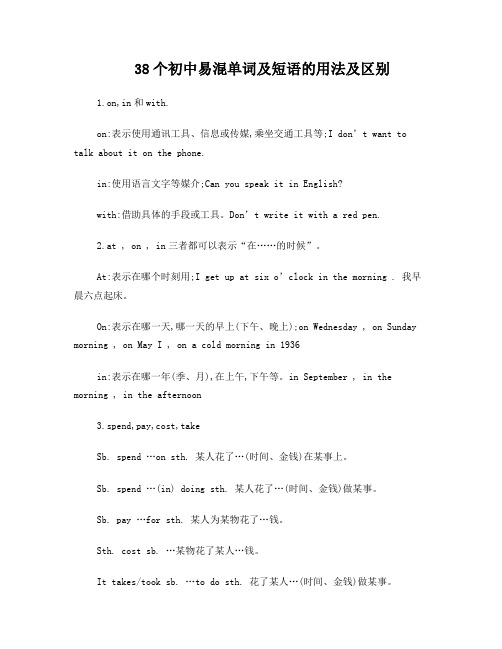
38个初中易混单词及短语的用法及区别1.on,in和with.on:表示使用通讯工具、信息或传媒,乘坐交通工具等;I don’t want to talk about it on the phone.in:使用语言文字等媒介;Can you speak it in English?with:借助具体的手段或工具。
Don’t write it with a red pen.2.at , on , in三者都可以表示“在……的时候”。
At:表示在哪个时刻用;I get up at six o’clock in the morning . 我早晨六点起床。
On:表示在哪一天,哪一天的早上(下午、晚上);on Wednesday , on Sunday morning , on May I , on a cold morning in 1936in:表示在哪一年(季、月),在上午,下午等。
in September , in the morning , in the afternoon3.spend,pay,cost,takeSb. spend …on sth. 某人花了…(时间、金钱)在某事上。
Sb. spend …(in) doing sth. 某人花了…(时间、金钱)做某事。
Sb. pay …for sth. 某人为某物花了…钱。
Sth. cost sb. …某物花了某人…钱。
It takes/took sb. …to do sth. 花了某人…(时间、金钱)做某事。
4.too much, too many, much tootoo much + 不可数名词too many + 可数名词much too + 形容词5.not …until &untilnot …until 直到…才…(主句动词是短暂性动词)until 一直到…(主句中使用延续性动词)6.few, a few; little , a little. 虽然都表示“少”,但(1)few, a few是可数的, little, a little是不可数的。
初中英语易错易混辨析归纳

易错易混辨析1. a bit 与a little①在肯定句中,a bit=a little,意为“有点儿”,修饰形容词或副词。
另外,a little还可以修饰不可数名词,意为“一点儿”。
Your article is a bit/a little long.There is only a little food left.②在否定句中,not a bit=not at all,意为“毫不”;not a little =very,意为“非常”。
The old man says that he is not a bit tired but in fact he is not a little tired.2.about与on都表示“关于”①about表示的内容较为普通,不是特别正式。
A book about Lei Feng②on表示严肃的或学术的A book on African history.3.above,on与over在......之上①表示位置高于某物(反below)Our office is above the shop.②表示物体表面相接触(反beneath)There is a glass on the desk.③表示垂直的上方(反under)There is a lamp hanging over the desk.4.accept与receive①表示主观上接受②表示客观上收到The girl received a gift,but she didn’t accept it.例题.I didn’t mean to trouble Curry yesterday. It was pouring with rain so I his offer of a lift. A.refused B.received C.allowed D.accepted5.across,throug与over①across在某个平面穿过②through从立体空间里穿过③over从上方越过The Great Wall winds its way from west to east ,across the deserts,over the mountains,through the valleys,till at last it reaches the sea.例题.You must be careful when you swim the lake.A.acrossB. belowC.overD.through6.ago与before①ago表示从事情发生到现在过去了多久(和一般过去时连用)②before表示从事情发生到过去某个时间是多久(可以和过去时或完成时连用)A week ago I went to see him ,but his father said that he had left two weeks before.7.agree with ,agree to 与agree on①agree with指“同意某人或某人的意见、观点、决定、想法、安排、解释”等,其后可以是一个名词或人称代词,也可以是what引导的从句。
初中英语易混词辨析

初中英语易混词辨析enjoy,like,love,preferenjoy,like,love和prefer都可表达“喜爱”的意思,但含义和用法有所不同。
enjoy在意义上侧重于“享受某种乐趣”,后接名词或动名词作宾语,不能接不定式。
enjoy还可以与反身代词连用,即“enjoy oneself”,表示“玩得很高兴”(= have a good time)The man is enjoying his dinner. 那个男人正津津有味地吃饭。
My father enjoys listening to the radio. 我父亲爱听广播。
Did the children enjoy themselves in the park? 孩子们在公园里玩得愉快吗?like意为“喜欢、喜爱”,是一般用语,主要是指对某人或某物产生好感或发生兴趣,不带有感情色彩,后面可接名词、代词、动名词、动词不定式作宾语。
Everyone in China likes Mid-Autumn Day. 在中国,每个人都喜欢中秋节。
He likes his students to work hard. 他喜欢他的学生努力学习。
love表示“爱、热爱、爱戴”,有强烈的感情,相当于like…very much,侧重于对祖国及较亲近的人的深厚感情。
在口语中它往往又指一般的喜爱,这时与like的意思相近,可以互换。
后面也可以接名词、动名词或动词不定式。
We love our motherland. 我们热爱我们的祖国。
They love playing/to play basketball. 他们爱打篮球。
like和love都可与would,should连用,表示“愿意做某事”。
I’d like/love to go with you. 我愿意和你们一起去。
prefer意为“(比较)喜欢、宁愿”,相当于like…better,它的“喜欢”是带有选择性的,是在比较的情况下选择出来的,其后接名词、代词、动名词或不定式。
初中英语易混淆知识点总结

初中英语易混淆知识点总结一、时态的混淆1. 一般现在时与现在进行时:一般现在时表示习惯性动作或普遍真理,而现在进行时则表示正在进行的动作。
例如,She always helpsothers(她总是帮助别人)与She is helping others now(她现在正在帮助别人)。
2. 一般过去时与过去进行时:一般过去时表示过去某一确定时间发生的动作,而过去进行时则强调过去某一时刻正在进行的动作。
例如,He walked to school yesterday(他昨天走路去学校)与He was walking to school this time yesterday(昨天这个时候他正在走路去学校)。
3. 现在完成时与现在完成进行时:现在完成时表示过去发生的动作对现在有影响,现在完成进行时则强调从过去某一时间开始一直持续到现在的动作。
例如,I have finished my homework(我已经完成了我的作业)与I have been working on my homework(我一直在做我的作业)。
二、介词的使用1. in, on, at:in用于表示在某个范围或区域内部,on表示在表面上,at表示某个点。
例如,在桌子上(on the table)、在公园里(in the park)、在五点钟(at 5 o'clock)。
2. to, for:to表示方向,目的地,for表示目的,受益方。
例如,I am going to the library(我要去图书馆)与I am buying a bookfor you(我为你买本书)。
三、冠词的误用1. the, a, an:定冠词the用于特指某个已知的人或物,不定冠词a/an用于泛指。
例如,The sun rises in the east(太阳从东方升起)是固定搭配,而A cat is a lovely pet(猫是一种可爱的宠物)则泛指任何一只猫。
易混动词辨析(初中英语专题复习)

易混动词辨析(初中英语专题复习)【易混辨析】【图解助记】cost /pay/ take /spend的区别:cost 的主语通常是事或物(包括形式主语it),不能是人;pay 的主语只能是人,常与for连用;spend 的主语也只能是人,构成spend on sth.或spend in doing sth.;take的主语常常是形式主语it。
如:The computer cost (me) $2000. 这台电脑花了(我) 2000 美元。
I have spent all day looking for you. 我花了一整天来找你。
It took him an hour to write the letter. 他写这封信花了一个小时。
She paid 10 yuan for this book. 她买这本书花了10元钱。
1.keep作及物动词,意为"使……保持(某种状态)"、"使得……"时,常用于以下几种结构:(1)keep+宾语(由人或物充当)+形容词。
Keep your hands clean. 手要保持干净。
(2)keep+宾语+副词。
What have kept you awa for so long? 什么事使你离开这么久?(3)keep+宾语+v-ing。
I’m sorry to have kept you waiting. 对不起,让你久等了。
(4)keep+宾语+v-ed。
Keep the door clsed. 让门关着。
(5)keep+宾语+介词短语。
Don’t keep your hands in your pockets. 不要把手插在口袋里。
2.keep作及物动词,后接名词作宾语,构成动宾结构,意为"保存"、"保留"、"记(日记等)"、"经营(商店等)"、"遵守(诺言等)"之意。
I keep a diary in English.我用英文记日记。
She keeps a bllkstore.她经营一家书店。
初中英语常见易混淆词语辨析

词语辨析1.because;since;as;for这四个词作为连词,都有“因为”的意思,都有可能用来为一个动作或情况提供原因或理由,但它们在用法上有区别。
because是从属连词,接表示直接原因的从句,一般放在主句的后面(需强调时,也可放在句首),直接明白地说明因果关系。
回答why的提问时,必须用be- cause。
例如:Because he is ill,he can't go to school.因为他病了,所以不能上学。
(生病是不能上学的直接原因)—Why didn't she come?她为什么没来?—Because she had an important meeting to attend.因为她有个重要会议要参加。
as是从属连词,只说明一般的因果关系,语气比because弱,说明比较明显的原因,它引导的从句通常放在句首,有时也可放在句尾。
例如:As he was not well,I decided to go without him.因为他身体不好,我决定独自去。
since意为“既然”,表示对方已知晓,无需加以说明的原因或事实,语气比because弱,但比as强,全句重点落在主句上。
例如:I'll do it for you since you are busy.既然你忙,我来替你做吧。
Since everybody is here,let's begin our meeting.既然大家都到了,我们开会吧。
for是并列连词,用来附带解释或说明前一分句的原因或理由,有时它表示的理由是推测性的,for引导的句子一般放在句子后部。
例如:We must leave now ,for the film begins at seven.我们得走了,因为电影七点钟开始。
Day breaks ,for the birds are singing.天亮了,因为鸟在叫。
(完整版)初中英语中考易混易错同义词辨析大全
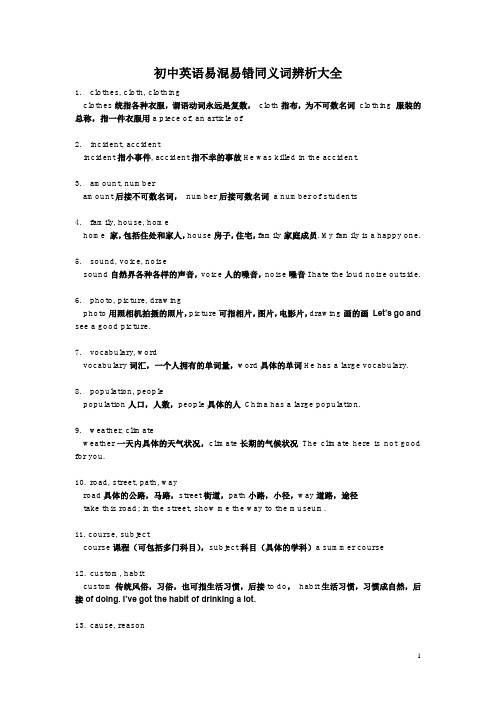
初中英语易混易错同义词辨析大全1.clothes, cloth, clothingclothes统指各种衣服,谓语动词永远是复数,cloth指布,为不可数名词clothing 服装的总称,指一件衣服用a piece of, an article of2.incident, accidentincident指小事件, accident指不幸的事故He was killed in the accident.3.amount, numberamount后接不可数名词,number后接可数名词a number of students4.family, house, homehome 家,包括住处和家人,house房子,住宅,family家庭成员. My family is a happy one.5.sound, voice, noisesound自然界各种各样的声音,voice人的嗓音,noise噪音I hate the loud noise outside.6.photo, picture, drawingphoto用照相机拍摄的照片,picture可指相片,图片,电影片,drawing画的画Let’s go and see a good picture.7.vocabulary, wordvocabulary词汇,一个人拥有的单词量,word具体的单词He has a large vocabulary.8.population, peoplepopulation人口,人数,people具体的人China has a large population.9.weather, climateweather一天内具体的天气状况,climate长期的气候状况The climate here is not good for you.10.road, street, path, wayroad具体的公路,马路,street街道,path小路,小径,way道路,途径take this road; in the street, show me the way to the museum.11. course, subjectcourse课程(可包括多门科目),subject科目(具体的学科)a summer course12.custom, habitcustom传统风俗,习俗,也可指生活习惯,后接to do,habit生活习惯,习惯成自然,后接of doing. I’ve got the habit of drinking a lot.13.cause, reasoncause 指造成某一事实或现象的直接原因,后接of sth./doing sth,reason用来解释某种现象或结果的理由,后接for sth./doing sth. the reason for being late14.exercise, exercises, practiceexercise运动,锻炼(不可数),exercises练习(可数),practice(反复做的)练习Practice makes perfect.15.class, lesson作"课"解时,两者可以替换.指课文用lesson. 指班级或全体学生用class. lesson 6; class 516. speech, talk, lecturespeech指在公共场所所做的经过准备的较正式的演说,talk日常生活中的一般的谈话,讲话,lecture学术性的演讲,讲课a series of lecture on…17.officer, officialofficer部队的军官,official政府官员an army officer18.work, job二者均指工作。
初中英语考试必考重点词语辨析汇总
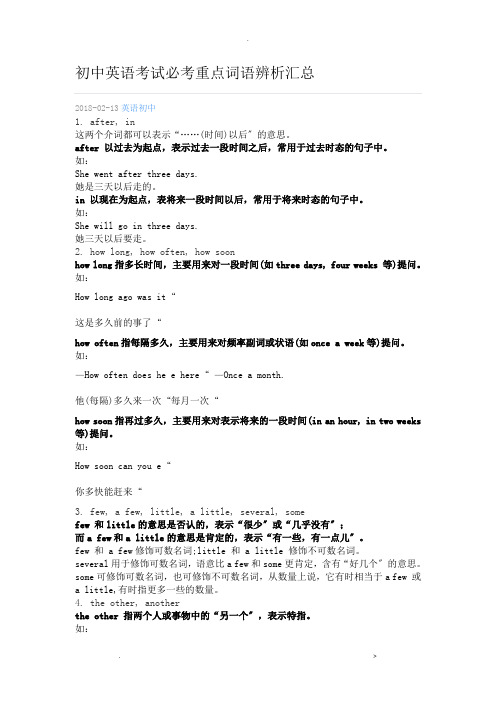
初中英语考试必考重点词语辨析汇总2018-02-13英语初中1. after, in这两个介词都可以表示“……(时间)以后〞的意思。
after 以过去为起点,表示过去一段时间之后,常用于过去时态的句子中。
如:She went after three days.她是三天以后走的。
in 以现在为起点,表将来一段时间以后,常用于将来时态的句子中。
如:She will go in three days.她三天以后要走。
2. how long, how often, how soonhow long指多长时间,主要用来对一段时间(如three days, four weeks 等)提问。
如:How long ago was it“这是多久前的事了“how often指每隔多久,主要用来对频率副词或状语(如once a week等)提问。
如:—How often does he e here“—Once a month.他(每隔)多久来一次“每月一次“how soon指再过多久,主要用来对表示将来的一段时间(in an hour, in two weeks 等)提问。
如:How soon can you e“你多快能赶来“3. few, a few, little, a little, several, somefew 和little的意思是否认的,表示“很少〞或“几乎没有〞;而a few和a little的意思是肯定的,表示“有一些,有一点儿〞。
few 和 a few修饰可数名词;little 和 a little 修饰不可数名词。
several用于修饰可数名词,语意比a few和some更肯定,含有“好几个〞的意思。
some可修饰可数名词,也可修饰不可数名词,从数量上说,它有时相当于a few 或a little,有时指更多一些的数量。
4. the other, anotherthe other 指两个人或事物中的“另一个〞,表示特指。
初中英语语法——易混动词用法辨析

初中英语语法——易混动词用法辨析1.agree with,agree to和agree on*agree with...指“同意某人或某人的意见、观点、决定、方法、安排、说明”等,其后能够是一个名词,也能够是what引起的从句。
如:I don’t agree with you.I don’t agree with what you said.*agree to...是指“同意某打算、建议、或建议”等;后跟动词原形,意为“同意干某事”。
如:Who else will agree to this suggestion besides him?We agreed to start early.*agree on...指在某方面取得一致的看法或意见。
如:We agree on leaving for Beijing the next day.2.answer和reply*answer是常用词,可指口头、笔头,甚至行动回答,有时可与reply 通用。
如:Who can answer the question?Please answer the telephone.*reply较answer正式,既可指用语言、书面作答,也可指用动作或手势作答,常用于正式场合或书面语中,指通过慎重考虑作出的答复。
如:I sent in my application,and the school replied immediately.3.apologize to和apologize for*apologize to sb.相当于say sorry to sb. 表示“向某人道歉”。
如:You should apologize to the old man.*apologize for sb.意为“替某人道歉或认错”。
如:4.argue about和argue with*argue about指“为某事而争辩、争吵”。
如:Don’t argue about the matter any more.*argue with指“为某人争吵、争辩或吵架”。
初中英语易混淆知识点

初中英语易混淆知识点篇一:初中易混淆知识点讲解初中易混淆知识点讲解一、spend,cost,take和pay都可以表示“花费”,但用法却不尽相同It takes(took) sb. +金钱或时间 to do sthSb. spend(spent) +金钱或时间 on sthSb. spend(spent) +金钱或时间 (in) doing sthSth cost(cost) + 金钱Sb. pay(paid)+ 金钱 for sthspend的主语必须是人,常用于以下结构:(1) spend time /money on sth. 在??上花费时间(金钱)。
例:I spent two hours on this maths problem. 这道数学题花了我两个小时。
(2) spend time / money (in) doing sth. 花费时间(金钱)做某事。
例:They spent two years (in) building this bridge. 造这座桥花了他们两年时间。
(3)spend money for sth. 花钱买??。
例:His money was spent for books. 他的钱用来买书了。
cost的主语是物或某种活动,还可以表示“值”,常见用法如下:(1)sth. costs (sb.) +金钱, 某物花了(某人)多少钱。
例:A new puter costs a lot of money. 买一台新电脑要花一大笔钱。
(2) (doing) sth. costs (sb.) +时间,某物(做某事)花了(某人)多少时间。
例:Remembering these new words cost him a lot of time. 他花了大量时间才记住了这些单词。
注意:cost的过去式及过去分词都是cost,并且不能用于被动句。
take后面常跟双宾语,常见用法有以下几种:(1) It takes sb. +时间+to do sth. 做某事花了某人多少时间。
初中英语相似(易混)短语辨析

初中英语相似(易混)短语辨析(一)1.a bit ;a little【辨析】两者均可作程度状语,修饰形容词或副词,常可换用。
如:He came here a little (a bit)early.他来的有点早。
a little可用作形容词,直接修饰不可数名词,a bit则不能,但可与of构成短语,其功能与a little相似。
如:Give me a bit of (=a little)milk ,please.请给我一点牛奶。
注意:not alittle(much)“很多”,“不少”;not a bit (=not at all)意为“一点也不”,“一点儿也没有”。
『练习』用a little a bit填空① He is_______ taller than Tom.② There is ______water in the glass.Keys:①a bit②a bit/a little③a little/a bit of2.a few ;a little【辨析】这两者均可表示“一点(儿),一些”。
但a few 修饰可数名词,而a little 修饰不可数名词。
『练习』用a few a little填空① He knows______English.② I am going to buy ______apples.Keys; ①a little ②a few3.afraid of afraid to;afraid for(about)【辨析】afraid of---意为“害怕;忧虑;担忧”,后可接名词、动名词或从句,它着重强调对可能产生的后果担忧或忧虑。
如:She was afraid of walking her husband up.她担心会吵醒她的丈夫。
afraid to ----意为“害怕,不敢”,后接原形动词,它着重指不敢或害怕去做某事。
如:I am afraid to see him,我不敢见他。
初中英语易混动词辨析

易混动词及短语动词1.beat和win的区别beat表示“打败”,后面跟的宾语是对手;win表示“赢得”,后面跟比赛或活动等作宾语。
如:They beat the Giants by a score of 7 to 3. 他们以7比3战胜了巨人队。
Though it was not easy, they won the game at last. 虽然不容易,他们最后还是赢了比赛。
2.carry, take与bring的区别take是指将某物或某人从这里“带到”或“拿到”某处。
bring与take相反,是指将某物或某人从别处“带来”或“拿来”。
carry是指随身携带(背着、扛着、提着、抱着),不表明来去的方向。
fetch常指从说话地到另外一个地店,取回某物。
如:Please help me take it to the classroom. 请帮我把它拿到教室去。
May I bring Tom to see you next Monday? 我下周一能带Tom来见你吗?The box is heavy. Can you carry it? 这个盒子太重了,你能拿得起来吗?Fetch a glass of water for me, please. 请给我拿杯水来。
3.cross和across的区别cross与across都表示“穿过;横过"的意思。
但是cross 是及物动词,across是介词,across 是前面必须还要有谓语动词。
如:Is it safe to cross the road now? 现在过马路安全吗?Go across the bridge. You'll find the museum on the left. 走过这座桥,你就会在左边找到那个博物馆。
4.hear与listen to的区别动词hear与listen to之间的区别,同see与look at之间的区别非常相似。
- 1、下载文档前请自行甄别文档内容的完整性,平台不提供额外的编辑、内容补充、找答案等附加服务。
- 2、"仅部分预览"的文档,不可在线预览部分如存在完整性等问题,可反馈申请退款(可完整预览的文档不适用该条件!)。
- 3、如文档侵犯您的权益,请联系客服反馈,我们会尽快为您处理(人工客服工作时间:9:00-18:30)。
初中英语论文——易混点清单1. in/on在表示空间位置时,in表示在某个空间的范围以内,on表示在某一个物体的外表之上。
There is a bird in the tree. 树上有只鸟。
There is a picture on the wall. 墙上有张图。
2. this/that/these/those(1)this常常用来指在时间、地点上更接近讲话人的人和事,these是this的复数形式。
that常常用来指在时间、地点上离讲话人更远一点的人和事,those时that的复数形式。
例I want this car, not that car. 我想要这辆小汽车,不是那一辆。
Take these books to his room, please. 请把这些书拿到他房间去(2)在打的用语中,this常常指的是我,that常常指的是对方。
例如:This is Mary speaking. Who’s that 我是玛丽。
你是谁?3. There be/ haveThere be "有",其准确含意为"某处或某时存在某人或某物。
"其构造是:There be + 某人或某物+ 表示地点或时间的状语。
There be 后面的名词事实上是主语,be 动词的形式要和主语在数上保持一样,be动词后面的名词是单数或不行数名词时用is,名词是复数时用are。
There is a big bottle of coke on the table. 桌上有一大瓶子可乐。
There are many apples on the tree. 那树上有很多苹果。
have表示"拥有,占有,具有",即:某人有某物(sb. have / has sth.)。
I have two brothers and one sister.我有两个兄弟,一个姐姐。
That house has four rooms.那所房子有四个房间。
4. look/ see/ watch(1)look 表示“看、瞧〞,着重指仔细看,强调看的动作,表示有意识地留意看Look! The children are playing computer games. 瞧!孩子们在玩电脑嬉戏。
单独运用是不及物动词,如强调看某人/物,其后接介词atHe’s looking at me。
他正在看着我。
(2)see强调“看〞的结果,意思是“看到〞,see是及物动词,后面能干脆跟宾语。
如:What can you see in the picture 你能在图上看到什么?(3)watch“观看,凝视〞,表示聚精会神地观看、视察或凝视某事务的活动,强调过程,常用于“看电视、看足球、看演出〞等。
如:Yesterday we watched a football match on TV.昨天我们从电视上看了一场足球竞赛。
5.That's right./ That‘s all right./ All right. That’s right意为“对的〞,表示赞同对方的意见、看法或行为,确定对方的答案或推断。
"I think we must help the old man.""我想我们应当扶植这位老人。
""That's right."或"You're right.""说得对"。
That’“不用谢〞、“没关系〞,用来答复对方的致谢或愧疚。
例如:"Many thanks." "That's all right.""Sorry. It's broken." "That's all right."“行了〞、“可以〞,表示同意对方的建议或要求。
有时还可以表示“身体很好〞"Please tell me about it." "请把此事告知我。
" "All right.""好吧。
"6. say/speak/talk/tellsay:是最口语化的最一般的一个词,意为“说出〞、“说道〞,着重所说的话。
如:“I want to go there by bus〞, he said . 他说,“我要坐汽车到那里去。
〞speak : “说话〞,着重开口发声,不着重所说的内容,一般用作不及物动词Can you speak about him 你能不能说说他的状况?speak 作及物动词解时,只能和某种语言等连用,表达在对话中恰当运用词汇的实力。
She speaks English well.她英语说得好。
talk : 及speak 意义相近,也着重说话的动作,而不着重所说的话,因此,一般也只用作不及物动词,不过,talk 示意话是对某人说的,有较强的对话意味,着重指连续地和别人谈话。
如:I would like to talk to him about it . 我想跟他谈那件事。
tell : “告知〞,除较少状况外,一般后面总接双宾语。
如:tell sb. to do sth. /tell sb. not to do sth.Miss Zhao often tells us to study hard.7. do cooking/ do the cookingdo cooking 作“做饭〞解,属泛指。
do the cooking 特指某一顿饭或某一家人的饭。
cooking为动名词,不能用作复数,但前面可用some, much修饰。
从do some cooking可引出很多类似的短语:do some washing 洗些衣服do some shopping 买些东西do some reading 读书do some writing 写些东西do some fishing 钓鱼从以上短语可引申出另一类短语,不能用some, much或定冠词。
go shopping 去买东西go fishing 去钓鱼go boating 去划船go swimming 去游泳8. other/ others/ the other/ anotherother表其余的,别的,Have you any other questions你还有其他问题吗others 别的人,别的东西美国人,其他的是法国人。
the other表另一个〔二者之中〕one…,the other…One of my two brothers studies English, the other studies Chinese.我两个哥哥中的一个学习英文,另一个学中文。
another表三者以上的另一个,另一些There is room for another few books on the shelf.书架上还可以放点书。
9. some/ any(1)some和any既可修饰可数名词,也可修饰不行数名词。
但有以下两点须要留意。
some常用于确定句中,any常用于否认句和疑问句中。
如:There is some water in the glass.Is there any water in the glassThere isn't any water in the glass.(2)在说话者盼望得到确定答复的一般疑问句中,或在表示恳求,邀请的疑问句中,我们依旧用some。
如:Would you like some tea10. look for/ findlook for 意为“找寻〞,而find意为“找到,发觉〞,前者强调“找〞这一动作,并不留意“找〞的结果,而后者那么强调“找〞的结果。
例如:She can’t find her ruler. 她找不到她的尺子啦。
Tom is looking for his watch,but he can’t find it.汤姆正在找寻他的手表,但没能找到。
11. be sleeping/ be asleepbe sleeping 表示动作,意思是“正在睡觉〞;be asleep 表示状态,意思是“睡着了〞。
如:---What are the children doing in the room 孩子们在房间里做什么?---They are sleeping.他们正在睡觉。
The children are asleep now.如今孩子们睡着了。
12. How much/ How manyhow much常用来询问某一商品的价格,常见句式是How much is / are…How much is the skirt 这条裙子多少钱?How much are the bananas 这些香蕉多少钱?how much后加不行数名词,表示数量“多少“,how many后加可数名词的复数形式。
How much meat do you want 你要多少肉呀?How many students are there in your class 你们班有多少人?13. be good for/ be good to/ be good atbe good for 表示"对……有好处",而be bad for表示"对……有害";be good to表示"对……友好",而be bad to表示"对……不好";be good at表示"擅长,在……方面做得好",而be bad at表示"在……方面做得不好"。
Doing eye exercises is good for your eyes.做眼保健操对你的眼睛有好处。
Eating too much is bad for you health.吃的太多对你的身体有害。
Miss Li is good to all of us.李老师对我们全部的人都很友好。
The boss is bad to his workers.这个老板对他的工人不好。
Li Lei is good at drawing, but I'm bad at it.李雷擅长画画,但是我不擅长。
14. each/ everyeach 和every都有"每一个"的意思,但含义和用法不一样。
each从个体着眼,every从整体着眼。
each 可用于两者或两者以上,every只用于三者或三者以上。
